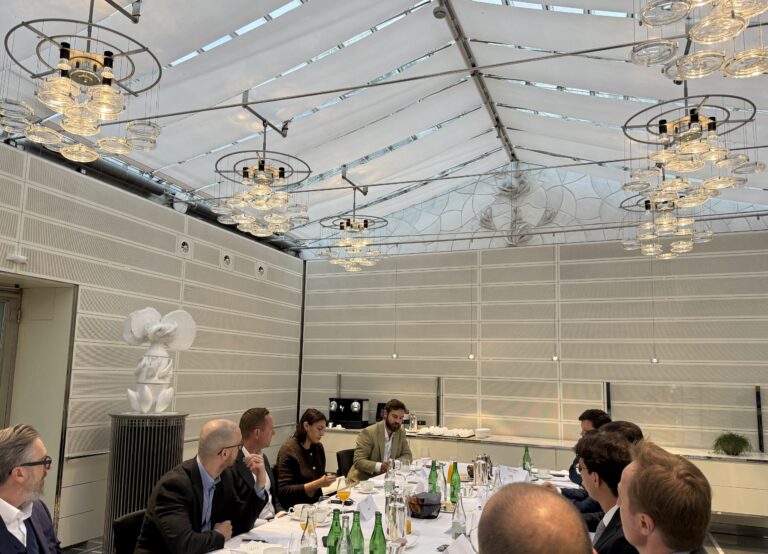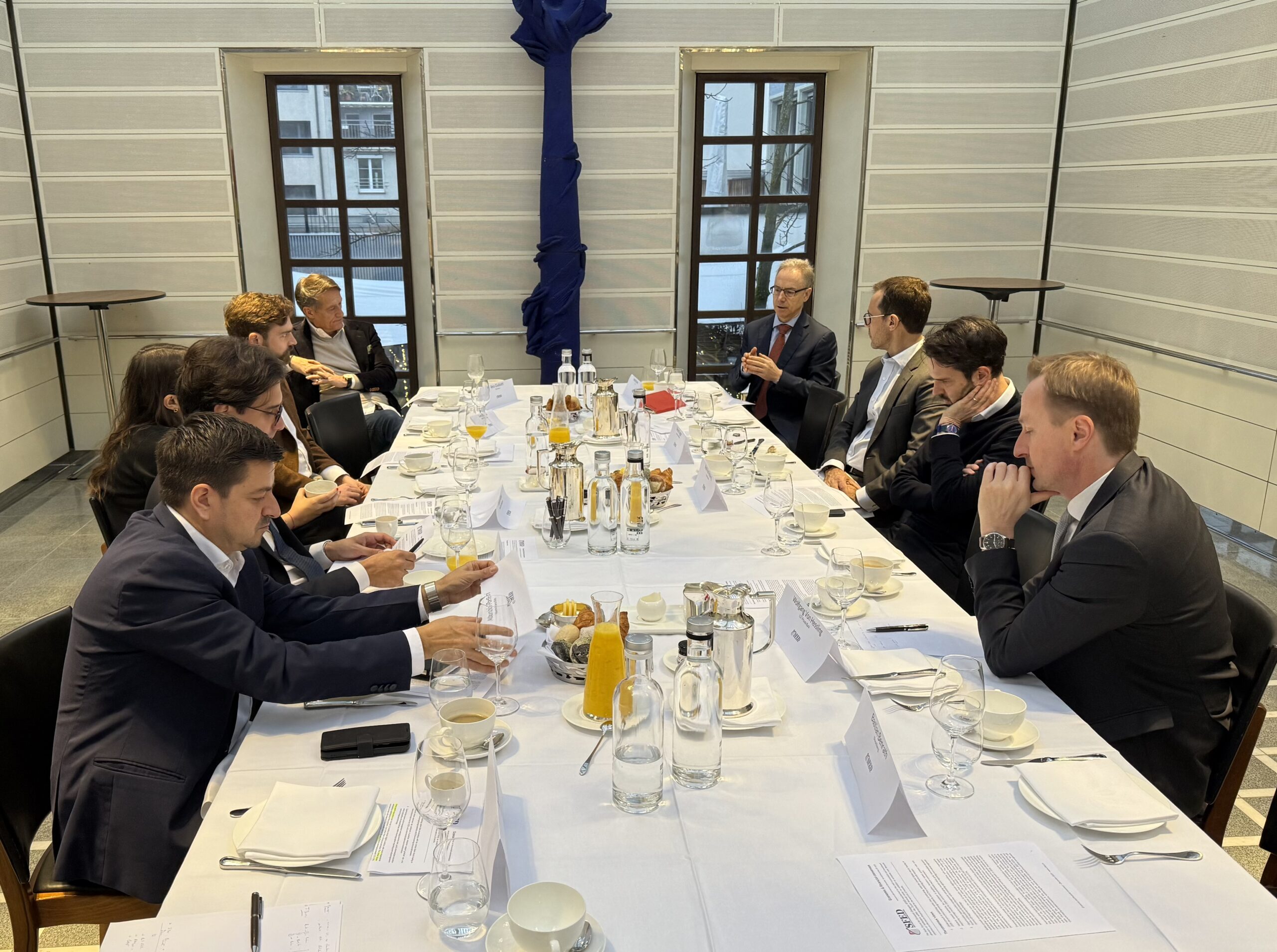Zurich strategists bet on slow recovery and lower rates
On September 9, 2025, the Swiss Forum for Economic Dialogues (SFED) gathered chief economists and investment directors from key institutions at Zurich’s Widder Hotel for a 90-minute roundtable discussion. Participants included Safra Sarasin, ODDO BHF, Baloise AM, Vontobel, Generali Origins Capital, LGT Bank, ZKB, and SZKB. The session aimed to outline a macro-financial outlook for the next 6 to 12 months, reflecting both global and Swiss-specific perspectives.
Growth and inflation outlook. Most Zurich-based strategists expect a moderate global slowdown without recessions. US GDP is forecast to expand by 1.7 percent in 2025 and ease slightly to 1.6 percent in 2026. Inflation in the United States is projected to hover around 3 percent at the end of this year before declining in 2026. Switzerland, in contrast, continues to face a low-inflation environment, reinforced by the latest deflationary CPI print in August. Eurozone growth remains modest but is expected to recover gradually in 2026, with Switzerland still outperforming despite tariff burdens.
Diverging views on monetary policy. Most participants foresee the Federal Reserve cutting rates by 100 basis points over the next 12 months as labor market conditions weaken. In Switzerland, opinions diverge on whether negative rates could return by late 2025 or mid-2026. In the Eurozone, however, there was consensus that French government bond yields are likely to move above Italian yields.
Equities: selective optimism. Equity market views were moderately positive. US equities are expected to remain driven by technology, with artificial intelligence seen as a long-term growth engine. Still, opinions differ: some warned of a bubble risk linked to rising energy demands and weaker corporate balance sheets, while others believe the cycle is only at an early stage. Europe remained a point of debate. While some investors underweight European assets due to French political instability, others see opportunities in French equities and argue that spreads with Germany remain manageable. Swiss large-cap defensives such as Nestlé, Novartis, and Roche are not expected to rebound in the short term, while mid-caps present uncertainty depending on the broader macro environment.
New investment themes. Beyond traditional asset classes, several themes emerged: (i) Private credit, viewed as more attractive than private equity given liquidity constraints. (ii) Commodities, with most participants positive on gold, though few expect it to reach 3,800 dollars by mid-2026. Oil prices are expected to rise amid persistent geopolitical uncertainty. (iii) Robotics, particularly attractive due to its exposure to the defense sector. (iv) Chinese ETFs, which continue to generate structural inflows, even if optimism on China’s near-term recovery was limited to two participants.
Currency expectations. Strategists anticipate continued US dollar depreciation, benefitting both the euro and the Swiss franc. Still, consensus suggests that EUR/USD will not reach 1.20, nor EUR/CHF 0.90, by mid-2026.
A measured but forward-looking dialogue. While divergences remain on monetary policy and equity opportunities, the Zurich roundtable highlighted the city’s role as a hub for constructive dialogue between banks, asset managers, and insurers. By confronting perspectives on global risks and sectoral opportunities, participants underscored the importance of measured optimism and selective positioning in a landscape shaped by shifting growth dynamics, geopolitical uncertainty, and technological disruption.
Insights from the Roundtable:
- Dr. Wolfgang von Hessling, Chief Economist, LGT Bank: “Elevated uncertainty and below-trend growth persist as trade tensions and tariffs drive diverging inflation trends: US inflation picks up on tariff pass-through while Eurozone inflation remains subdued. The Fed cuts rates in a « labor market risk management” fashion in 2025 still, followed by more “normalization-driven” cuts in 2026 as soon as the ongoing US inflation resurgence eases, while the ECB faces little pressure to act soon. This backdrop dampens an otherwise constructive equity outlook, keeps bonds volatile but selectively interesting, and points to broad USD weakness as monetary policy loosens. Gold remains a favored hedge amid persistent inflation volatility and robust demand.”
- Maurizio Porfiri, Chief Investment Officer, Maverix: « We expect developed markets to see mild cooling but remain in positive growth, while China and Emerging Markets face headwinds from tariffs. We maintain a constructive view on risk assets into 2026, supported by contained inflation and further rate cuts. US equities should be driven higher by earnings growth, with Technology, Financials and Industrials leading the way as the AI-driven rally continues. In rates, we see the US yield curve steepening and shifting lower into year-end. While markets have largely absorbed the tariff shock, we recommend downside protection given persistent tail risks. »
- Vincent Lagger, Portfolio Manager, Zürcher Kantonalbank: « Rates are still supportive to equities as financing costs fall for companies and banks globally. In the US, interest rates are expected to ease further as the emphasis has shifted towards the labor market post Jackson Hole. Furthermore, a falling USD makes for even looser global financial conditions, a favorable backdrop for emerging equities and to some extend small caps. Having said that, the recent fall in volatility offers an opportunity to buy cheap protection against long-tail risks«
- Pierangelo Franzoni of Origins Capital views the current macroeconomic and market landscape as conducive to a measured approach to equity and private equity investment over the medium term. He emphasizes a preference for companies with robust fundamentals, particularly in non-cyclical sectors that offer resilience amid uncertainty. Franzoni also sees compelling opportunities in credit and asset-backed finance, with a growing interest in thematic investments—notably in areas such as Agricultural Asset-Backed Finance (ABF), which he identifies as an emerging frontier increasingly attracting institutional capital.
- Wolf von Rotberg, Equity Strategist, J.Safra Sarasin: “We are neutral on equities vs. fixed income and have a preference for gold. With regard to our regional allocation, we are turning more positive on Europe. The outlook for improving euro area growth momentum at the beginning of 2026 and fairly attractive valuations are set to provide renewed support for European equities, which have trailed equities from the rest of the world over summer. We also see scope for Swiss equities to outperform, given that political risks regarding tariffs and the pharma sector appear fully discounted.”
- Ross Hutchison, Head of Eurozone Market Strategy & Economics, Zurich Insurance: “Risk-assets continue to climb the infamous ‘wall of worry’, despite geopolitical and trade turbulence. We see scope for further increases in global equity prices, as the Fed cut rates further. Within this, frontier technology markets including the US and China are still attractive as innovation surges at an accelerating pace, despite high valuations. On the other hand, European equities are less compelling in the short term, given exposure to tariffs and a risk of investor optimism waning.”
- Antonio Larocca, Portfolio Manager: “Trade frictions remain, but recent deals have lessened the likelihood of a full-scale global trade conflict, with US tariffs holding steady at high levels. The US economy is grappling with stagflation risks, as economic growth decelerates and inflation ticks upward. Meanwhile, European manufacturers must adapt to ongoing US tariffs, but are expected to gradually rebound, aided by German fiscal measures and previous interest rate reductions from the ECB. At the same time, concerns about fiscal dominance are mounting, particularly in the US, where rising borrowing costs and inflexible spending limit central banks’ capacity to control inflation. This environment could result in steeper yield curves and heightened market volatility, a greater chance of long-term bond sell-offs, especially if political pressures prompt central banks to keep rates artificially low or restart large-scale asset purchases.”
- Arthur Jurus, Head of Investment Office, ODDO BHF: “We maintain equities at slightly underweight. After the strong rally since April valuations have become somewhat stretched. Given high political and economic uncertainties the risk of a setback has increased. In addition, risks stem from the incrementally undermined independence of the FED. For Europe, implemented tariffs will also weigh on economic growth. We are constructive on credit risk as global recession risks have faded. Spreads are relatively tight, but overall yield levels still offer a good carry investment. From a risk-return perspective we continue to favor short duration Investment Grade and High Yield as the drawdown potential is low. Gold is still supported by outlook on long-term yields, demand from central banks and US fiscal issues. Finally, we are still positive on CHF in mid and long term.”




